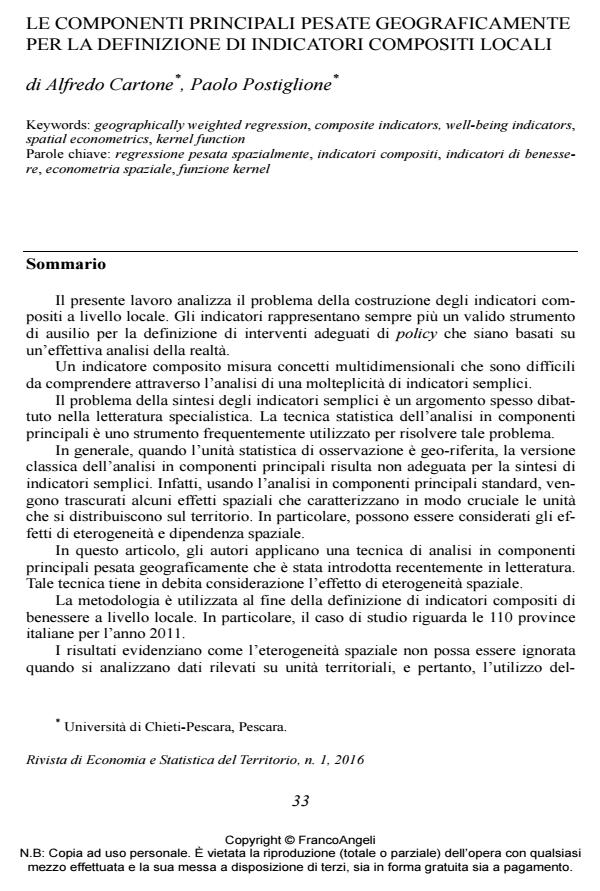Geographically Weighted Principal Component Analysis for the Definition of Composite Indicators
Journal title RIVISTA DI ECONOMIA E STATISTICA DEL TERRITORIO
Author/s Alfredo Cartone, Paolo Postiglione
Publishing Year 2016 Issue 2016/1
Language Italian Pages 20 P. 33-52 File size 200 KB
DOI 10.3280/REST2016-001002
DOI is like a bar code for intellectual property: to have more infomation
click here
Below, you can see the article first page
If you want to buy this article in PDF format, you can do it, following the instructions to buy download credits

FrancoAngeli is member of Publishers International Linking Association, Inc (PILA), a not-for-profit association which run the CrossRef service enabling links to and from online scholarly content.
The paper investigates the problem of the definition and the construction of composite indicators. The indicators are increasingly a valuable tool to assist people for the definition of appropriate policy that is based on effective analysis of real-world.
Methods and Results
Principal component analysis is often used to define composite indicators. Unfortunately, when dealing with spatial units, this technique is not appropriate, since it does not consider the spatial effects, namely spatial heterogeneity and dependence that are inherent characteristics in spatial data. To overcome this problem, the authors use a modified version of principal component analysis that has recently been introduced in literature and that explicitly considers the spatial heterogeneity effect. This method is denoted as geographically weighted principal component analysis. The method is applied for the definition of well-being composite indicators at local level for 110 Italian provinces. The analysis is performed for 2011.
Conclusions
The empirical evidence shows that the multidimensional concept of well-being is differentiated at local level, supporting the extent of spatial heterogeneity. Therefore, the obtained results support the use of the geographically weighted principal component analysis as more suitable method for handling spatial data.
Keywords: Geographically weighted regression, composite indicators, well-being indicators, spatial econometrics, kernel function
Jel codes: C01, C21, C43, C54.
- L'eterogeneità spaziale nello sviluppo locale in Italia: un'analisi basata sulla costruzione di un indicatore sintetico M. Simona Andreano, Roberto Benedetti, Andrea Mazzitelli, in RIVISTA DI ECONOMIA E STATISTICA DEL TERRITORIO 3/2017 pp.9
DOI: 10.3280/REST2016-003002
Alfredo Cartone, Paolo Postiglione, Le componenti principali pesate geograficamente per la definizione di indicatori compositi locali in "RIVISTA DI ECONOMIA E STATISTICA DEL TERRITORIO" 1/2016, pp 33-52, DOI: 10.3280/REST2016-001002